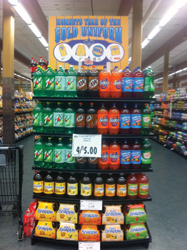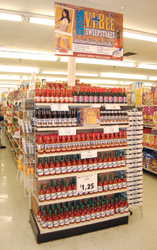Imagine spending $20,000 for a personal seat license in the lower bowl of your favorite team’s home stadium. Then the bill for the season tickets arrives in the mailbox. Would you opt not to pay it — realizing that you would be missing out on the key parts of the deal? The team’s efforts to engage you as a fan; the enjoyment you receive from going to the stadium.
The same could be said of a company paying for a corporate sponsorship with a team and not following through with activation, integration and measurement of that investment.
Leave any one of these three steps out, and all those concerned are left with an incomplete program, and likely many missed opportunities.
In early June, I had the privilege of attending the New Orleans Hornets partners’ summit in Biloxi, Miss. For the second consecutive year, the Hornets built their summit around these three steps, highlighting “AIM: Activation, Integration, and Measurement.”
As part of the program, the NBA team business and operations division and Turnkey Intelligence shared results from a 2010-11 research study. The study, covering 15 NBA teams and 44 corporate partners, captured fan metrics related to sponsor affinity, attitude and usage of brands, and other key elements geared toward improving the dialogue between properties and corporate partners. The Hornets were one of the 15 teams that participated in the study.
One partner included in New Orleans’ portion of the project was Rouses, a Louisiana-based grocery store chain and official supermarket of the Hornets. Fan feedback on Rouses and this partnership exceeded expectations across the board.
■ Activation
Contracts between sports properties and partners typically include inventory that helps the brand activate from the start. But the league, the Hornets and Rouses see merit in incremental activation both inside and outside the arena. Doing so engages fans, builds community presence, and often allows for easier measurement.
Tom Ward, senior vice president with the Hornets, has seen many successful examples of activation outside the arena and knows the value it adds. “The Hornets vendor program with Rouses provided our sponsors with a 360-degree advertising and activation campaign that delivered in-arena advertising, on-air broadcast media, and in-store promotional displays and merchandising. When we combined the market research results and Rouses’ sales figures, we were able not only to demonstrate the positive fan perceptions and behaviors related to the Hornets sponsorship, but also to quantify the ROI for our sponsors.”
■ Integration
Partnership marketing inside and outside of sports succeeds because the whole becomes greater than the sum of the parts. But if the parts are not seen, heard and experienced together, this synergistic effect goes away. Rouses has a unique vendor program, geared at ensuring that its logo appears not only with Hornets branding and players, but also other consumer packaged goods that partner with the Hornets. For instance, a shopper will see a Dr Pepper Snapple Group end-cap display featuring Hornets imagery and Rouses’ logo. The displayed beverages receive tremendous lift, benefiting both the brand and retailer. And the Hornets benefit because their partners are seeing meaningful results from the alliance.
 |
NEW ORLEANS HORNETS
Displays like these give visibility to Hornets marks, Rouses’ logo and a partner brand. |
■ Measurement
“To measure what our sponsors care about, we must understand their business objectives and planned activations,” states Valerie Camillo, vice president of analytics with the NBA. Of course, teams and partners will have shared this information long before any measurement studies are designed. Rouses’ objectives in partnering with the Hornets relate to consumer perceptions and behavior. Rouses hoped to accomplish these goals throughout the 2010-11 NBA season:
• Drive positive feelings about Rouses among Hornets fans, above and beyond non-fans.
• Highlight locally grown perishables, such as meat and produce.
• Drive shopping frequency and spending in Rouses.
The great thing about those goals is they are measurable; that is, research and analytics can provide clarity on whether the goals have been achieved. As a result of the project, Rouses and the Hornets discovered: (All differences cited are statistically significant at a 95 percent confidence level.)
• Hornets fans have stronger feelings for Rouses, compared with non-fans. Seventy-five percent of Hornets fans either “like” or “love” Rouses — compared with 52 percent of non-fans.
• A sports partnership can be used to drive perceptions about specific brand/retailer attributes. Sixty-one percent of Hornets fans cited Rouses as having the “best locally grown produce, seafood and meats.” Forty-three percent of non-fans said the same.
• The positive perceptions from Hornets fans translate into the behaviors Rouses would hope to see. Forty-two percent of Hornets fans chose Rouses as their preferred grocery store, compared with 21 percent of non-fans. Seventy-eight percent of Hornets fans had shopped at Rouses during the three months prior, much higher than the 55 percent of non-fans who had done so. And this gap in shopping behavior grew as the season went along.
Of course, it helps when activation lends itself to being measured. “For example, we can measure the sales lift provided by coupon redemption or an out-of-arena retail activation. We can also measure the benefit of straight signage deals, especially when brand positioning or other messages are used to complement logos,” Camillo said.
The AIM philosophy requires a partnership where the parties act as willing partners. Communication must be constant and open. A brand’s objectives and a property’s status will change during the length of a five-year contract. It’s not realistic to think that activation can remain static for the duration, but without proper communication, marketing tactics related to the partnership will not evolve.
“Our teams take their responsibility as business partners very seriously,” said Chris Granger, executive vice president of the NBA’s team business and operations division. “By understanding goals, creatively activating in support of those goals, and fostering environments of ongoing collaboration and consistent communication, our teams are laser-focused on furthering the business objectives of their partners.”
Steve Seiferheld (steveseiferheld@turnkeyse.com) is senior vice president of the custom research division of Turnkey Intelligence. Find him on Twitter @steveseiferheld.






